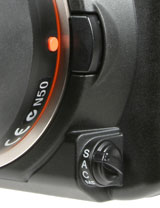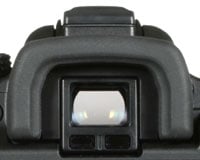Sony Alpha DSLR-A700 final production review
-
-
Written by Gordon Laing
Sony Alpha DSLR A700 lenses and bundles
Sony Alpha DSLR-A700 features continued…
Lenses and viewfinder / Screen and menus / Sensor and processing / Anti dust / Anti shake
The Sony A700 employs an Alpha lens mount and is compatible with the complete range of Sony lenses and third party models designed for the Sony or Minolta AF systems, including DT models. Interestingly unlike the A100, the polished metal surface of the lens mount extends a few millimetres beyond the trademark Alpha orange ring – see photo.
All lenses attached to the A700 can exploit the camera’s built-in (and according to Sony improved) Super SteadyShot stabilisation, and since the A700 employs the same physically sized sensor as the A100 before it, all lenses effectively have their field of view reduced by 1.5 times.

|
The Alpha A700 is available in three different lens bundles, or as a body alone. The three lens bundles include either the DT 18-70mm (the standard A100 bundle), the DT 16-80mm (a premium general purpose zoom from Carl Zeiss), or the DT 16-105mm (a new general purpose lens introduced with the A700).
We’ll be reviewing the new DT 16-105mm, which offers an equivalent 6.5x range of 24-158mm, in the future. In the meantime, we’ve already fully tested the other two kit lens options, so check out the Sony DT 18-70mm (as part of our A100 review) along with our complete DT 16-80mm review to see how they measure-up.
Three additional new lenses beyond the DT 16-105mm were launched with the A700: the DT 18-250mm f3.5-6.3 (offering a massive 14x optical range), DT 55-200mm f4-5.6 and the 70-300mm f4.5-5.6G SSM.
Sony Alpha DSLR A700 focusing
 |
The Sony A700 is equipped with a new 11-point AF system, which improves on the A100’s 9-point system; the new arrangement is diamond-shaped with two points at fairly wide positions to better track subjects off-centre. The A700 also features an LED-type AF illuminator and a new coreless AF motor that’s quicker and quieter than the A100’s motor, but still not as quick or quiet as lens-based systems like Canon’s USM, Nikkor’s SWM or Sony’s own SSM systems.
Like the A100 before it, the A700 offers the choice of four focusing modes: single-shot AF-S, direct manual focus DMF, continuous autofocus AF-C, or a hybrid AF-A mode which automatically switches between AF-S and AF-C. These modes are selected using a small dial to the lower right of the lens mount with the camera facing you, and there’s also a button on the back of the camera which uses a clutch to temporarily release the AF motor, allowing quick manual adjustments.
The A700 also inherits the A100’s Eye Start AF feature which can start the AF system as soon as sensors under the viewfinder detect the camera approaching your eye. If you’ve not used it before, it can be a little disconcerting, but does mean the A700 stands a good chance of already being focused on your subject before you even press the shutter release button – this can be great for spontaneous photography, but if you don’t like it, the feature can be switched off.
In terms of continuous AF performance, we photographed sequences of vehicles approaching head-on at 40kph over a distance from around 110m to 5m. The sequences typically lasted 10 seconds during which we’d fire-off around 50 frames. The success-rate with the A700 fitted with the Carl Zeiss 16-80mm when zoomed-into 80mm was very good with over 95% in sharp focus and the rest very close.
Sony Alpha DSLR A700 viewfinder
 |
The Sony A700 features a proper penta-prism optical viewfinder system which offers a 95% field of view, 0.9x magnification with a 50mm lens and 21mm of eye relief at -1 diopter. This is an improvement over the 0.83x penta-mirror arrangement of the A100 and in use the A700’s viewfinder does indeed look bigger and brighter, although perhaps not quite as big as Nikon’s D80.
Looking through the viewfinder you’ll see the 11 AF points arranged in a diamond pattern; 10 are short vertical or horizontal bars, leaving a small square in the middle. Four further horizontal bars near each corner indicate the framing area when the A700 is set to record images in the 16:9 aspect ratio.
Information running below the main framing area includes the same five-segment chart as the A100 which indicates how hard the Super SteadyShot stabilisation system is working, along with the usual exposure details, although sadly Sony’s not taken the opportunity to show ISO at all times; it is shown on the main colour screen though.





